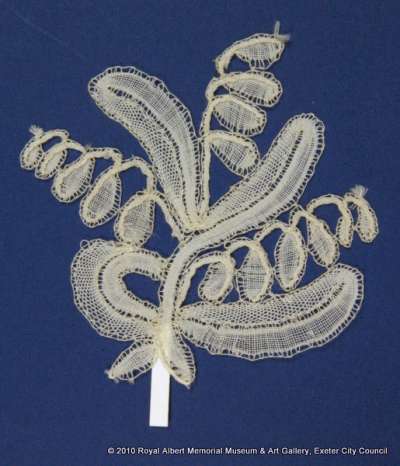Honiton (East Devon) lace sprig
This is an example of East Devon (Honiton) lace, in the form of a sprig. By the middle of the nineteenth century lace-makers were producing individual sprigs or motifs which were then joined or ‘sewed’ together with bobbins, or could be stitched to a net ground which was usually machine made. As technology for spinning stronger and smoother cotton yarns improved, more and more lace was made with cotton threads rather than linen. The lace motifs were constructed on a pillow using bobbins wound with thread, woven around pins following a pattern known as a pricking. The same technique is still used in East Devon lace-making today.
The sprigs often depict well-known garden or wild flowers. Here is a lily of the valley. The plant has three stems of raised work flowers and four leaves with both whole and half stitch areas joined by ‘sewing in’ to the join.
The sprigs often depict well-known garden or wild flowers. Here is a lily of the valley. The plant has three stems of raised work flowers and four leaves with both whole and half stitch areas joined by ‘sewing in’ to the join.
Object Summary
- Accession Loan No.
- 40/1923/3/1
- Category
- Decorative Art
- Collection Class
- Textiles and equipment
- Material
- cotton
- Common Name
- Honiton (East Devon) lace sprig
- Simple Name
- lace sprig
- Period Classification
- Victorian (1837-1901)
- Production Date
- 19th century
- Production Person Initials
- S.
- Production Person Surname
- Moore


